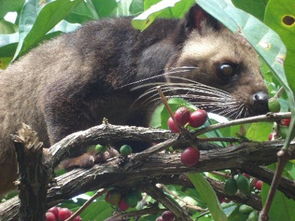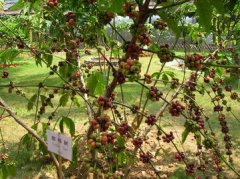The world's most expensive coffee Kopi Luwak
Kopi Luwak is a traditional specialty in some Indonesian islands, such as Java, Sumatra, Bali and Sulawesi. The civet only contains this unique coffee in its feces after eating the local coffee cherry fruit. In fact, the official name of Kopi Luwak is Kopi Luwak. Kopi means "coffee" in Indonesian, while Luwak is a wild civet in Indonesia.
Sheng Zhen, a staff member of the Indonesian Pavilion, said that in order to get precious "cat poop coffee beans," local farmers in Indonesia would put civets into cages to feed themselves, and some coffee merchants simply packed an island to keep these cats. Let them enjoy the natural environment of sunshine and rain. "the civets eat and pull by themselves, and you can't force them to eat or pull, so the coffee beans in the excrement are very precious!" It is reported that this rare coffee produces only 500 pounds a year. The raw materials of this kind of coffee are difficult to obtain, and the production process is very complicated, and it must go through strict sanitary procedures, such as drying, roasting, brewing and so on. However, the final coffee will produce a unique flavor, so it is very expensive.
The distillation process of Kopi Luwak was demonstrated at the scene. "12 grams of Kopi Luwak, distilled with 50 to 55 grams of water, so that the final coffee is the most mellow." The coffee grounds left by Kopi Luwak are also very unique, smooth and without holes, which can't be done by ordinary coffee.
Do you know where the most expensive coffee in the world comes from? The answer is Indonesia. What is even more peculiar is that the raw material of this kind of coffee comes from cat droppings! At the Indonesian Pavilion at the World Expo, people can taste this strange coffee.
Recently, the Indonesian Pavilion of the World Expo displayed Kopi Luwak, the star of the Indonesian food festival. A cup of 4 oz coffee can sell for US $168 (about 1400 yuan). The rarity of this coffee is that it comes from the droppings of a wild musk cat in Indonesia.
In the coffee shop of the Indonesian Pavilion, 20 grams of Kopi Luwak costs 380 yuan, which is much higher than other kinds of coffee. According to the staff of the pavilion, coffee lovers are still flocking to drink a cup of Kopi Luwak in Hong Kong, which costs 220,298 yuan.

Important Notice :
前街咖啡 FrontStreet Coffee has moved to new addredd:
FrontStreet Coffee Address: 315,Donghua East Road,GuangZhou
Tel:020 38364473
- Prev

Coffee basic knowledge there are many advantages and functions of drinking coffee.
Dr. Ritchie and others of the French National Health and Medical Research Center have completed a large study. The researchers asked about 7000 average 74-year-old men and women in Bordeaux, Dijon and Montpellier about how many cups of coffee and tea they drank each day, as well as drugs and Coca-Cola with small amounts of caffeine. The subjects took several mental skills tests. The quiz consists of a series of
- Next

Two of the oldest native species of coffee
Typica: the oldest native variety in Ethiopia, all Arabica are derived from Tibika. It belongs to the ancient coffee with elegant flavor, but its physique is weak, its disease resistance is poor and it is easy to catch rust leaf disease, and its fruit yield is also low, which is not in line with economic benefits. In recent years, Tibika has been gradually replaced by Kaddura and Kaduai in Central and South America, which is becoming more and more rare. Although Tibica has a good flavor, it is not as good as it is.
Related
- Beginners will see the "Coffee pull flower" guide!
- What is the difference between ice blog purified milk and ordinary milk coffee?
- Why is the Philippines the largest producer of crops in Liberia?
- For coffee extraction, should the fine powder be retained?
- How does extracted espresso fill pressed powder? How much strength does it take to press the powder?
- How to make jasmine cold extract coffee? Is the jasmine + latte good?
- Will this little toy really make the coffee taste better? How does Lily Drip affect coffee extraction?
- Will the action of slapping the filter cup also affect coffee extraction?
- What's the difference between powder-to-water ratio and powder-to-liquid ratio?
- What is the Ethiopian local species? What does it have to do with Heirloom native species?

